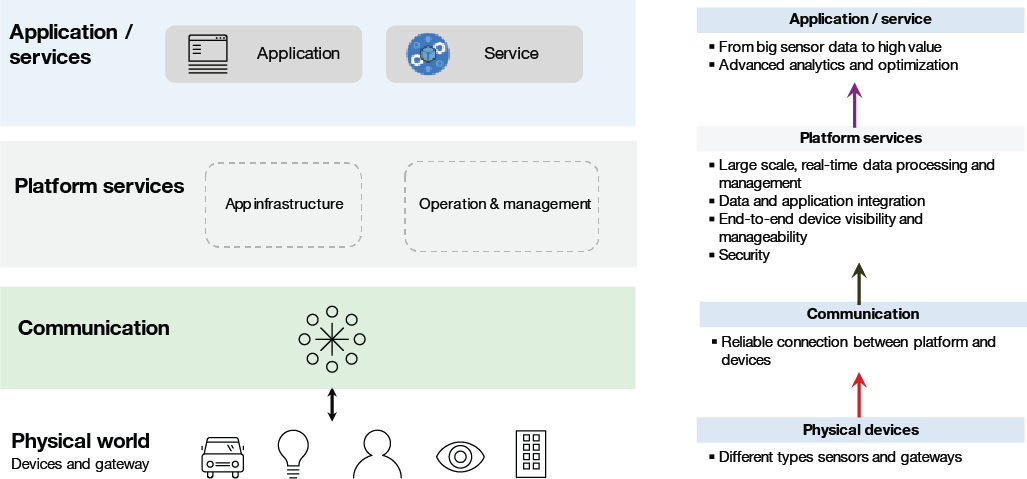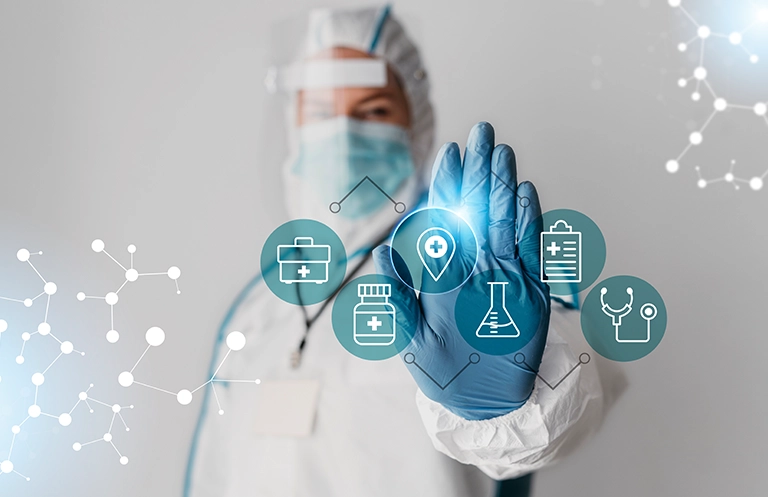IoT is not a buzzword but necessity
Internet of Things provides a host of business opportunities for organizations and governments to design, develop, and deploy smart connected devices. Many government institutes, enterprises, and even consumers are using the power of IoT, Big Data, and Artificial Intelligence for creating strategic business models for enhancing the quality of human lives.
One of the biggest advantages of IoT is in healthcare, wearable devices like smartwatches or fitness trackers help to collect vital information like monitor sleep patterns, measure heart rate, and more. The wearable devices allow to track the irregularities that are otherwise imperceptible, monitor baby cribs, and even provide emergency care to the elderly.
Technology companies see the potential for a variety of applications and adoption of these functions to improve human lives. For example, recently Apple has announced the new features of their smartwatches that include measuring glucose levels, tracking blood pressure, and monitoring heart health status.
As with many other technologies, using IoT the vendors, implementers, operators, policy-makers, and regulators are aiming to maximize the benefits of connected devices while minimizing potential risks to security and privacy.
How big is the IoT market?
As the number of connected IoT devices grows, the amount of data generated by these devices will also grow. According to a new IDC forecast, the growth in connected IoT devices is expected to generate 79.4ZB of data in 2025. “IoT” has been the buzzword for years but past decade we have seen its increased adoption by businesses. As per Gartner, connected endpoints for IoT has nearly reached 5.8 billion in 2020.
The development of wireless networks, reduction in the cost of connected devices, demand for customized IoT applications, an increase in operational efficiency, and enhanced customer needs for customized products are the key reason for the huge adoption of IoT in these days. Let’s deep dive into the key technology drivers of IoT adoption:
Key Drivers for IoT Adoption
IoT is becoming an integral part as devices are expected to be connected. , which is creating more opportunities for IoT adoption. Let us see the technology factors driving the IoT adoption,
- Rapid development of wireless networking methods
- Emergence of advanced data analytics
- Increased coverage of networks and enhanced levels of data speed
- Reduction in the cost of connected devices
- Enhanced customer experience
- Enhanced adoption of cloud platforms
- Innovations in product offerings
- Increased operational efficiencies
- Maturity of the IoT solutions being offered
Common Challenges in Implementing IoT Solutions
Implementing IoT solutions has become complex as we need to integrate connected devices with IT services which impose major challenges in networking, real-time data analysis, security, and communication. An IoT solution incorporates many different technologies and requires a strategic development cycle starting from designing, deployment, testing to continuous monitoring, and support. Let’s deep dive into some of the most common challenges in implementing IoT solutions.
Security & Privacy
Maintaining the security of internet connected devices is one of the most critical challenges for implementing IoT solutions. The increasing number of connected devices giving rise to security threats as poorly designed devices can easily expose data to cyber theft.
One of the examples of IoT security threats is with healthcare devices. The cyber attackers can control and access people’s health and can put their health at risk by misconfiguring the devices.
Some of the common security threats with IoT devices are
- Malware infiltration
- Credential theft
- Social engineering attacks
- Device misconfiguration
- Phishing attacks
- Privilege escalation
Security should be the topmost priority of your IoT strategy as it could affect both company and consumer as well.
In an IoT ecosystem, devices are interconnected with different software and hardware, which creates a huge possibility of leaking data through unauthorized access to these devices. For example, many time voice recognition or vision features are used to listen and watch the activity which transmits the data to cloud for processing and providing customized services. The process uses many interfaces or third party applications without proper encryption which leads to leakage of personal information including, email id, phone number, credit card details among others.
Scalability
Billions of devices are connected to a network that processes large volumes of data every day. The system that stores analyze, and processes the huge data should be scalable as per the requirement. It further requires cloud storage capabilities and big data analytics for the interpretation of useful data for further business actions.
Interoperability of Different IoT systems
One of the critical challenges with IoT is Interoperability. As many new OEMs, vendors, and service providers are coming in the market, it becomes really difficult to maintain the interoperability between different IoT devices and systems. As per the market analysts, McKinsey, 40% to 60% of the total values lies in our ability to achieve interoperability between different IoT systems.
There are no specific standards as of now. The technological standards are still fragmented. The standards would help us to establish a common framework for IoT devices. As there are no standards defined the interoperability of IoT with legacy devices has become more critical. This is stopping us from moving towards the vision of truly connected everyday smart objects.
Connectivity
Connectivity is crucial when you are building an IoT solution. It is an important aspect of all your IoT device networking. As there are still limitations with network availability and speed, connectivity is observed to one of the biggest challenges in IoT deployments. Connectivity becomes more challenging for businesses like Oil & Gas where we require a robust communication networks as these companies are mostly located in remote areas. The quality and speed of signals collected from connected devices depending on the network type LAN, MAN, and WAN.
Integration of IoT Devices with IoT Platforms
Integrating the connected devices with the right IoT platform is often seen as a challenging task. The lack of proper integration of devices with the desired IoT platform may lead to improper functioning and also result in a decrease in efficiency to deliver value to the customers.
Research vice president at Gartner, Benoit Lheureux, says “Through 2018, half the cost of implementing IoT solutions will be spent integrating various IoT components and back-end systems. It is vital to understand integration is a crucial IoT competency.”
The important aspect here is there are too many devices with lots of endpoints that need to be connected and transmit crucial information to an IoT platform. That is why the selection of the right IoT platform becomes essential. With successful integration, you can mine a large amount of data that can be used to make important business decisions.
IoT Roadmap
For a successful implementation of IoT solutions the organization should first define a technical strategy. A typical technical strategy comprises of
- Designing and developing a reference architecture
- Deciding the technology platform
- Developing the required process
- Develop and operate IoT solutions
IoT Roadmap Deep Dive
IoT roadmap consists of a series of activities that involve carefully defining roles, responsibilities, and deliverables.
- Prepare
- Define Objectives
- Perform skill assessment and build the team
- Define success criteria
- Setup IoT CoE
- Engage IoT architect
- Define reference architecture
- Define
- Define a delivery approach
- Define security solution
- Develop prototype
- Evaluate prototype
- Refine architecture
- Assess risk and mitigation Approach
- Develop
- Develop device specification and fabrication
- Develop Provider evaluation and engagement
- Develop the platform integration
- Develop testing
- Deploy
- Provision devices
- Integrate data and applications
- Deploy management solution
- Operate
- Maintenance
- Automation
- Monitoring
- Measure achievement
- Scale Up
Overall the IoT roadmap should cover all business, technical and operational requirements, and constraints. In addition to that, it should address the current and future business requirements and adapt future technical or business changes.
IoT Architecture
IoT reference architecture defines the required functionality, how the functionality will operate, and how the data and control will flow through the entire IoT process.
A typical reference architecture is consisted of devices, server-side capabilities, and cloud architecture to manage the devices. A reference architecture should provide an effective starting point for the IoT architects and developers to addresses major IoT project and system requirements.
5 layers of IoT architecture
Basically, there are five layers in an IoT architecture:
- Application/Services Layer
- Platform Services Layer (Bridge for connecting clients and operators)
- Communication Layer (Server Side Operations)
- Physical devices layer (Client-side)
- Data Layer

Application layer
The application layer manages the collection, processing, and analysis of large chunks of data generated from sensors in near real time. It supports a very high data rate, which is higher than the general IT infrastructure. It acts as the interface between the IoT device and the network.
The application layer has the authority to provide services to the applications. The service may vary based on the specific information collected by the sensors.
Platform layer
Basically the platform layer act as a platform for managing critical sensor data, integration of applications, and device management. The platform layer supports messaging, including data collection, data mediation, dispatching, and security management.
Communication layer
The communication layer provides a reliable network for managing and controlling the sensor data. It acts like a bridge that carries and transmits data gathered from physical objects through sensors. The medium can be wired or wireless. It also connects network devices and networks. Hence, it is extremely sensitive to cyberattacks. The communication layer helps us manages the integrity and authentication of data that is being transmitted to the network.
Physical devices layer
It supports the range of devices, sensors, and gateways. It also supports remote monitoring and management of connected devices. The sensor layer has the responsibility to recognize things and gather the data from them. The sensors that collect data from the objects can be 2D barcode or RFID. These sensors are selected as per the requirement of applications. The data generated from the sensors can be related to motion, location, vibration, or even changes in the air and environment.
Data layer
The data layer runs through all the layers viz. application layer, platform layer, communication layer, and the physical device layer. The data layer consists of a series of activities which involves
- Data Streaming
- Event processing
- Data processing and management
- Decision Making
Roles and Responsibilities of an IoT development team
The essential roles and responsibilities of an IoT development team consisted of following
IoT developer– IoT developer is one who defines and implements tasks like data collection, messaging, applications, and data analysis.
Data analyst– Data analyst performs activities like data collection, data modeling, data mapping, analysis, and reporting.
IoT tester– An IoT tester performs end to end testing of connected devices and also test device capability and perform security testing in order to maintain privacy.
Device SME-Device SME finalizes the specific device requirements and the IoT solution architecture and helps in selecting the right devices for the IoT solution. For a seamless set up of communication networks for IoT devices, the device SME works with the infrastructure architect. The device SME also finalizes the device management principles and policies including device physical security and cybersecurity.
IoT architect– IoT architect defines the IoT platform strategy and integration of solutions components as per the IoT platforms. They also create an end to end solution architecture based on the adopted reference architecture. They work closely with the infrastructure architect and security architect for the seamless implementation of IoT solutions.
Security architect– The security architect defines an end-to-end security solution for the IoT device. The role of a security architect involves data analysis, infrastructure, and application security requirements and analysis of network operational environment security. The security architect is also responsible for creating privacy solutions and security governance practices.
ROI of an IoT Solution
For any business, the prime objective is to deliver a higher quality product and services at minimal cost by using the existing resources. To satisfy the customer needs the business must continually innovate and improve efficiencies and be more productive and drive profitable growth.
Looking at the adoption rate of IoT and digital transformation initiative IoT can helps businesses generate new revenue streams, improving productivity, and cost efficiencies for delivering better customer experience. Let us see some of the key metrics that can be used to measure the value of an IoT solution
- Increased revenue
- Decreased downtime
- Waste reduction
- Improved performance
- Streamlined business processes
- Better quality customer service
- Reduced risk
- Improved visibility
- Increase health and safety
- Increase productivity
- Increased efficiency
- Optimization
- Better security
- Asset utilization
eInfochips’s IoT Success Stories
IoT Platform Development for Connected F&B Appliances
A US based Food & Beverage Company had limitations with their existing blender platform. They were facing issues like functionality, remote diagnostics, and scaling to newer markets. The client was looking to develop the next generation IoT platform. Such that the platform can be easily and quickly scaled both domestically and internationally as per the requirements. Also, the platform should provide complete visibility to real time data and remote control of blenders.
eInfochips designed and developed Azure based next generation IoT management platform, blender operating system, data storage, and retailer portal solution. eInfochips help them improved the reliability of the blender and enabled the client to have real-time access to the blender data, including blender screen content, devices & users, diagnostics, predictive analytics, etc.
Project Key Highlights
- Design and development of Azure cloud native IoT platform
- Analytical models for failure prevention and TAT reduction
- Remote device management & diagnostics
- 20,000+ connected blenders
Full-stack Development of IoT Home Security Solution
eInfochips has been engaged with a billion dollar telecom company for eight years now and has helped them develop the entire home automation platform. With time, as the number of users started surging, it became difficult to scale and manage. The client was looking to upgrade its platform with the latest technology architecture that could be scaled to millions of users at minimal costs.
eInfochips developed a new microservices based architecture with full-stack expertise using NoSQL database and DevOps implementation. eInfochips helped them to cut the release cycle time by 3-% and help them achieve the desired scalability, catering to millions of users now.
Project Key Highlights
- End-to-end development of the entire home automation platform
- Subscriber and device management web portal development
- Cross-platform mobile app development
- DevOps implementation and Microservices architecture
- PaaS implementation
- Co-operative installations with other Digital Home Stacks
AWS Migration for a Smart Agri IoT Solution
A billion dollar company in the electronic domain, which also provides smart Agri solutions had developed an IoT platform for effective utilization of renewable energy by connecting a set of sensors on the field that operate and monitor water pumps. However, the IoT platform architecture was not robust enough to handle the high volume of data, while incurring high infrastructure and operational costs. The client was looking to upgrade the existing IoT platform architecture.
eInfochips assessed the existing architecture and help them developed an entire IoT platform migration to AWS (Amazon Web Services), utilizing various AWS services. The cloud-native design enabled a future-ready Agri-IoT platform and reduced their operational and infrastructure costs.
- AWS migration
- Future-ready IoT platform
- Cloud native design
- Reduced operational costs
Why eInfochips for IoT Consulting Solutions & Services?
eInfochips provides end to end IoT Consulting Services that ensures high availability, resilience, reliability, and scalability and addresses all the key challenges in the IT-OT convergence, including security and interoperability challenges.
- Providing intelligent cloud – AWS, AZURE, IBM Watson, MindSphere, and Google Cloud
- Scalability to more than 55 Million digital nodes
- Interop Enabling edge Intelligence for various hardware platforms
- Interoperability with other IoT Ecosystems: Google Home, Nest, IoTivity, and Alexa
Conclusion
As said earlier, IoT is not a buzzword anymore but a necessity. Investing in IoT and implementing the right IoT solution can give fast paybacks-Increased productivity, lower operating and infrastructure cost, improve quality, better and faster decision making. In short, your goal should always be to have a competitive ROI for IoT projects development.
eInfochips provide customized IoT solutions and services from IoT application development, IoT security, and connect device management to remote device management. We help businesses in implementing a highly scalable, reliable, and cost-efficient infrastructure using various IoT platforms (AWS/GCP/Azure). We assist customers in deploying IoT solutions that increase productivity, efficiency, and profitability.
To learn more about IoT Solution Development, please don’t hesitate to contact our team of experts.
References:
https://www.gartner.com/smarterwithgartner/iot-integration-questions
https://www.analyticsinsight.net/heres-why-smart-iot-is-future
https://blog.apnic.net/2015/10/20/5-challenges-of-the-internet-of-things













